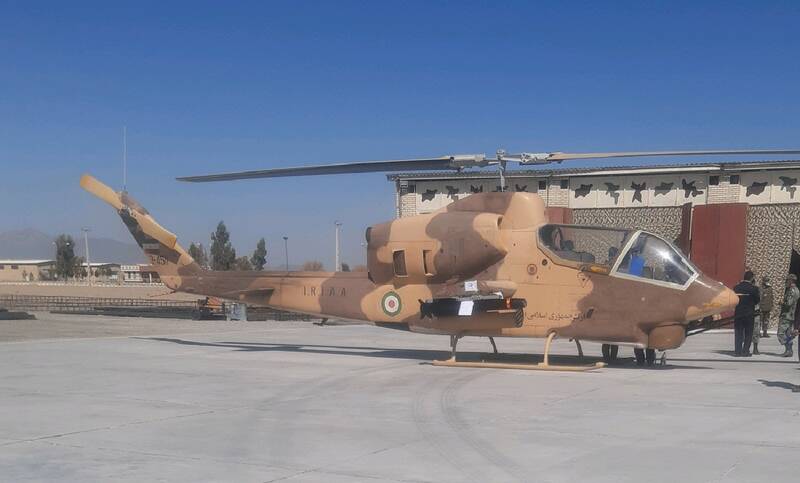
A Shafagh missile mounted on an Iranian Bell-114 helicopter.
“The missile… is capable of destroying multiple ground targets in all weather conditions.”
Almost five years to the day after the Iranian Army unveiled a prototype short-ranged, “Shafagh” air-to-ground missile, Iranian Army Ground Force Commander Brig Gen. Kioumars Heydari announced that the Army has now equipped its aviation wing with a new generation Shafagh. In the accompanying article from Mashregh News,a source close to Iran’s intelligence and security apparatus, Heydari described the short-range missile as utilitarian, capable of mounting on manned and unmanned fixed-wing aircraft as well as helicopters, and able to find targets in all weather and times of day. The description of the Shafagh offered in the Iranian press suggests the missile is the Iranian equivalent of an AGM-114 Hellfire, though Iranian officials claim a slightly larger warhead and greater range. Even if Iranian figures exaggerate their claims regarding the Shafagh’s capabilities, an increased precision to drone-launched missiles could complicate regional operations for the United States, its Arab allies, and Israel.[i]
While Iran has recently modernized its helicopter fleet, Heydari’s emphasis on helicopter operations is curious, given both the vulnerability of helicopters to longer-range missiles and the lack of obvious use in the regional environment.[ii] If the Iranian military wanted to attack shipping in the Persian Gulf, for example, utilizing anti-ship missiles or drones would prove far less risky. Iran’s preference for proxy warfare to maintain plausible deniability and to avoid direct confrontation with superior military powers makes the use of helicopters to support operations unlikely. Heydari’s unveiling of the Shafagh, therefore, may have more to do with Iran’s ambitions to be a military export power. Iranian commanders say that Iran’s indigenous military industry “stands among the world’s top states” regarding both drones and high-precision missiles. While Iran now reportedly exports drones to Russia among other states, a proliferation of Hellfire-like missiles to regional proxies in Syria, Iraq, Lebanon, and Yemen—all of which already utilize Iranian drones—might augment the lethality of these groups. So too would the export of helicopters to Iran’s regional allies like Syria or Yemen’s Houthi-led government. Given the frequency of drone and missile strikes across the region, any increase in precision will reduce the diplomatic space to refrain from military retaliation in response to attacks perpetrated by proxies or militias. After all, it is more politically feasible to wave off retaliation for a strike that misses rather than one that strikes key infrastructure or kills multiple soldiers or officials.
Source:
“Nasib-e Nasal-e Jadid Mushakha-ye ‘Shafagh’ Ruye Balgaradaha-ye Havaniruz- Artesh (Installation of a New Generation of Shafagh Missiles on Army Helicopters),” Mashregh News (news source close to Iran’s intelligence and security apparatus), 9 April 2023. https://www.mashreghnews.ir/news/1360280
The new generation of “Shafagh” [Twilight] missiles that have special operational capabilities, compared to previous models were installed on Army Aviation’s Cobra and [Bell-] 214 helicopters. The missile, which is 1.9 meters long and weighs about 50 kilograms, is capable of destroying multiple ground targets in all weather conditions, and is also useful for night operations. The new model also has a range of 20 kilometers, a significant increase compared to previous generations. The new Shafagh missiles can be installed on all types of helicopters, drones, and fighters. They have laser guidance, travel at a speed of 750 meters per second [1678 mph] and can destroy both moving and stationary targets within a radius of 15-20 kilometers. They are precise to a margin of 0.20 meters.
The two-stage missile, using a 13-kilogram warhead, has significant penetration power and can destroy all types of armored systems. It can destroy, for example, tanks, personnel carriers, concrete trenches, floats, and other defense infrastructure.
The prototype Shafaghs are actually based upon the Shahab-e Saqeb defense missile that uses an infrared imaging seeker. This technology has the ability to track armored and floating targets from all angles, has a relatively high resistance to jamming and deception, and has much better sensitivity in detecting targets.One of the advantages of this missile, which is similar to a Hellfire missile, is the ease of deployment and the need not to have to stabilize the helicopter in front of a target. Rather, the Shafagh is in the category of ‘shoot-and-forget’ missiles.
Notes:
[i] This is not the first time Iran has claimed enhanced missile precision. See: Michael Rubin, “Iran Claims Enhanced Missile Precision” OE Watch, May 2017. https://community.apan.org/wg/tradoc-g2/fmso/m/oe-watch-past-issues/195361/download
[ii] Michael Rubin, “Iran: Reconstruction and Overhaul of Helicopters” OE Watch, March 2021. https://community.apan.org/wg/tradoc-g2/fmso/m/oe-watch-past-issues/368233/download
Image Information:
Image: A Shafagh missile mounted on an Iranian Bell-114 helicopter.
Source: https://cdn.mashreghnews.ir/d/2022/04/09/4/3446518.jpg
Attribution: Mashregh News
